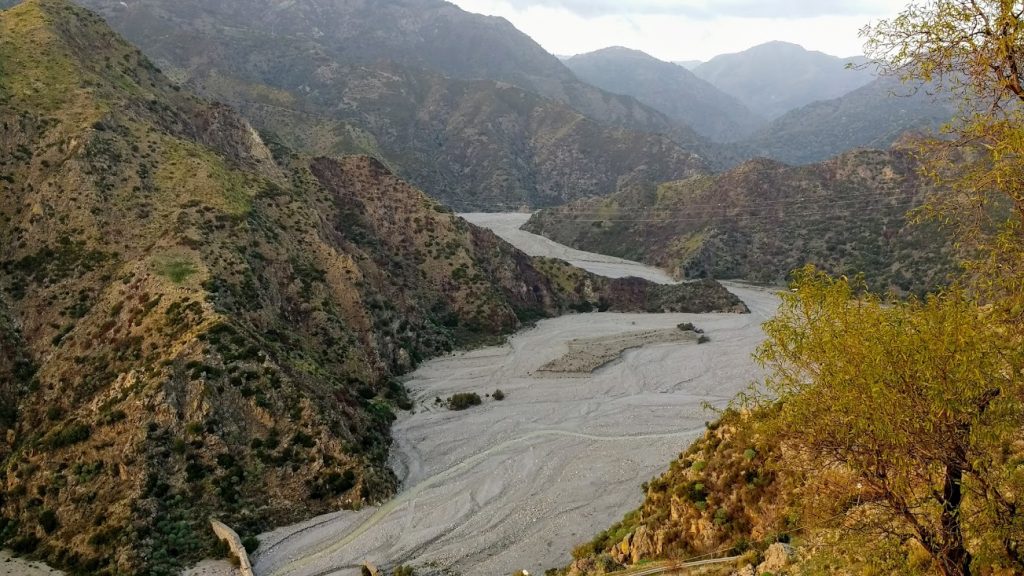A 360-degree panorama of untamed, natural beauty surrounds the Castle of Amendolea, whose ruins cling precariously to a narrow, rocky cliff on the southern tip of the Italian peninsula. The high ridge dominates the entire valley and is crowned by the abandoned fortification and village, a ghost town with an incredible view. A visit to Amendolea is a leap back in time, to a Calabria of long ago.
AMENDOLEA IN HISTORY

The Castle in Amendolea framed by almond blossoms (photo courtesy of Lillo Minniti, Gruppo Archeologico Valle dell’Amendolea)
“… we had long passed the level of the Castle of Amendolía, and were looking down into its empty courts, …and truly magnificent was the view, looking back from the points of rock where we frequently halted to rest… The immense perspective of diminishing lines and torrents, finished by the complete and simple outline of Etna beyond the sea, is certainly one of the very finest scenes to be found even in beautiful Italy.”
Journals of a Landscape Painter in Southern Calabria by Edward Lear
The British artist and writer was captivated by the scenic vistas he found on his exploration of the Province of Reggio Calabria in 1847. Remarkably, Lear traveled through the hills and mountains of Southern Calabria on foot. On the day in question, he was hiking between the towns of Condofuri and Bova, and as he got underway described Amendolea as being “half way up to the skies.” As Lear noted, the castle surveys the entire valley, its wide riverbed and irregular hills that lead from the Aspromonte Mountains to the Ionian Sea, Sicily and Mt. Etna on a clear day.

The Castle and Valley of Amendolea (courtesy of Enzo Galluccio, calabriagreca.it)
Today, Amendolea is a district of Condofuri, but for centuries this strategic castle was an important center of the valley, an historically Greek-speaking area with the Amendolea River at its core, Amiddalìa Potamò in Calabrian Greek. While this land has been home to ancient peoples, documented evidence of the settlement on this high rock dates to the 11th century and coincides with the initial construction of a castle. By Lear’s time, the castle had been abandoned as a result of the geological ramifications and structural devastation caused by the earthquake of 1783. The village continued to be inhabited by about 300 people, but was severely damaged in the 1908 earthquake that had its epicenter in the Strait of Messina and was completely vacated following a disastrous flood in 1953. A small village populated by those who hadn’t moved to Condofuri or Reggio was built at the foot of the rock.

Modern Amendolea, district of Condofuri (photo courtesy of Enzo Galluccio at www.calabriagreca.it)
VISITING AMENDOLEA

Amendolea River Wash
The road from the coast up to the ghost town runs alongside the Amendolea River, a fiumara as it is called in Italian, which is a wide, rocky bed that is dry for much of the year, but with a torrential capacity to accommodate the heavy flow during winter rains and spring thaws. Crossing a bridge over the river, the route climbs past the younger village and continues on a very steep, narrow road, which may prompt out-of-town drivers to stop the car and consider hiking the rest of the way. Of course, that is always an option, but the paved road continues up to the ghost town, complete with a small parking area and an old sign pointing towards the “Castello dei Ruffo.”

Castle ruins in Amendolea (photo courtesy of Enzo Galluccio, calabriagreca.it)
From its Norman beginnings, the castle has had many owners and has been restructured numerous times. The last of the aristocrats to possess the fiefdom was the Ruffo family, who bought the castle in 1624 and maintained it until the end of feudalism. Thus, the castle is often referred to as the Ruffo Castle. Today, the Amendolea castle, its old village and the nearby churches are an archeological area of the Condofuri community within the Aspromonte National Park.
From the parking area, a path leads up to the crest of the hill. To the right, a long, steep staircase goes to the castle area and a trail to the left passes around to the village; they end up in the same place. The terrain is mildly challenging and not for unruly children as the only barrier between the visitor and the fiumara below is common sense.
MEDIEVAL CASTLE AND VILLAGE IN SOUTH ITALY

Amendolea Fiumara
Climbing the stairs and pausing for breath, reaching the top and looking over the edge, I am struck by nature’s drama playing out across the broad riverbed that weaves along the base of the rough-hewn hills. Its source is in the heart of the Aspromonte Mountains, just a few kilometers from the coast, but seemingly a world away. Low-lying clouds enhance the sense of mystery.

The ruins of the old village of Amendolea (photo courtesy of Enzo Galluccio, calabriagreca.it)
After a thousand years of habitation on top of this rocky mount, the medieval ruins hold the merest hint of the generations who lived, loved and toiled for the castle, in the village and on the surrounding land. The formidable castle walls have refused to crumble and today, dramatically pose for photos taken by visitors who choose to veer from the beaten path.

Amendolea Castle Ruins
A great hall with large, arched windows overlooking the valley, a chapel with shadows of original frescos, a large cistern, towers and the fortification wall are outlined amongst the castle remains. Further south, shells of the former homes cluster on the edge of the precipice.

Ruins of a house in Amendolea
The village church with the typical layout, orientation and niches of the Greek Orthodox faith dates back to at least the early 14th century, according to tithing records of the local priest at the time.

Chiesa dell’Assunta – Church of the Assumption with Greek layout
The ruins of three other churches from the 11th to the 15th centuries lie outside the castle area, the older of which still preserves a bit of traditional Byzantine painting.
AMENDOLEA: Ghost Town Enthusiasm
Wandering amongst the medieval ruins, enjoying breathtaking panoramas and benefiting from the fresh air—these are all good reasons for a visit to Amendolea. However, on my most recent stopover, I was fortunate to have the ciliegina sulla torta or the icing (literally, glazed cherry) on the cake. I’m not talking about the delicious food of the region, which is more than a story in itself, but the guide who escorted me through the ruins, Francesco Manglaviti, the director of the Gruppo Archeologico Valle dell’Amendolea (Amendolea Valley Archeological Group).
His knowledge and enthusiasm for Amendolea and the area of Calabria’s Greek heritage was infectious, from the castle’s archeological history to the renewal and use of the old mule trails. And in the end, isn’t that what it’s all about? Who knows what could or would have been, had Amendolea not suffered such devastating blows at nature’s hand.
Ghost towns entice with their veiled mystery and peculiar beauty, but only real people can make them come alive.

Amendolea Ghost Town
The Ìmmasto cultural association introduced me to the Gruppo Archeologico Valle dell’Amendolea, which has frequent excursions for the love of exploring, and anyone with a passion for history and hiking can join them. Thank you to Enzo Galluccio at Calabria Greca for the use of several photos. (More information on the links.)
 Read more about other towns with Greek heritage on this blog, such as Gallicianò: Greek Culture in Calabria, Pentedattilo: A Ghost Town in Calabria and Palizzi: Yesterday and Today. And for an in-depth look at the beautiful land in the toe of the boot, check out Calabria: The Other Italy, my non-fiction book about daily life, history, culture, art, food and society in this fascinating southern Italian region. It’s available in paperback and e-book versions. Has your interest been piqued? Perhaps you might like to travel to the region on my Calabria Tour.
Read more about other towns with Greek heritage on this blog, such as Gallicianò: Greek Culture in Calabria, Pentedattilo: A Ghost Town in Calabria and Palizzi: Yesterday and Today. And for an in-depth look at the beautiful land in the toe of the boot, check out Calabria: The Other Italy, my non-fiction book about daily life, history, culture, art, food and society in this fascinating southern Italian region. It’s available in paperback and e-book versions. Has your interest been piqued? Perhaps you might like to travel to the region on my Calabria Tour.
“Like” Calabria: The Other Italy’s Facebook page and follow me on Karen’s Instagram and Karen’s Twitter for more beautiful pictures and information.
Sign up below to receive the next blog post directly to your email for free.

Comments 16
How gorgeous and mystical, especially with the fiumara in the background. I can just imagine how spooky it looks in the fog! Ciao, Cristina
Author
It would also be strange to imagine the narrow crest with an active castle and houses full of people, all grouped together with nature playing out all around them. A far cry from life today.
Intriguing, possible link to my heritage.
Author
Even more interesting, then!
I cannot imagine having to construct that castle upon the hill! Is the Edward Lear you mention the famous for his limericks and “Book of Nonsense”?
Author
Yes, one in the same! He was a very talented man.
We visited Pentedattilo in Calabria a couple of years ago and found it fascinating. Now there is another ghost town to visit.
Author
Yes, Italy is just full of old places waiting to be visited. Pentedattilo is perhaps Calabria’s most famous abandoned village although it is starting to show some signs of life.
Yes, there are now a couple of shops and bars to cater for visitors, so it is no longer totally abandoned.
We have an abandoned village in a Bagni di Lucca which is slowly disappearing into the forest.
I have just resubscribed to your blog. I don’t know what happened that I disappeared from it.
Author
Sorry that you were somehow unsubscribed from my blog, but I’m glad you’re back.
I really appreciate this post and i am very surprised that someone is so interested in Calabria as you in this blog. I am curious now to read and go through your blog to read more. Greetings from Bova Marina.
Author
I’m glad you enjoyed this post. I lived in the Province of Reggio Calabria for 4 years and developed my interest and love for the region during that time, after which I wrote Calabria: The Other Italy and began this blog in which I continue to explore the region. I have also begun to organize tours to Calabria. Best to you in Bova Marina.
Loving these ghost town blogs. Absolutely intriguing.
Author
Thanks! The ghost towns are indeed fascinating although also sad for those who were forced to move away.
Loved reading about Calabria. would enjoy learning more about the region as it is on my radar to visit in fall of 2020 when i spend 2 months in Italy.
Author
Glad you liked the post – it’s just the tip of Calabria’s iceberg. Click around my blog, there are 100 more articles about the region. And for a good overall picture of the region, there’s my book Calabria: The Other Italy. Have a wonderful trip!